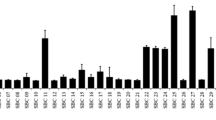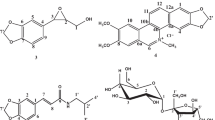Abstract
Bacteria use quorum sensing signalling in various functions, e.g. while forming biofilms, and inhibition of this signalling could be one way to control biofilm formation. The aim of this study was to evaluate the production of signalling molecules and its correlation with the biofilm formation capability of bacteria isolated from brewery filling process. A further aim was to study berry extracts and wood-derived terpenes for their possible quorum sensing inhibitory effects. Out of the twenty bacteria studied, five produced short-chain and five long-chain AHL (acyl homoserine lactone) signalling molecules when tested with the Chromobacterium violaceum CV026 reporter bacterium. Production of AI-2 (autoinducer-2) signalling molecules was detected from nine strains with the Vibrio harveyi BB170 bioassay. Over half of the strains produced biofilm in the microtitre plate assay, but the production of AHL and AI-2 signalling molecules and biofilm formation capability did not directly correlate with each other. Out of the 13 berry extracts and wood-derived terpenes screened, four compounds decreased AHL signalling without effect on growth. These were betulin, raspberry extract and two cloudberry extracts. The effect of these compounds on biofilm formation of the selected six bacterial strains varied. The phenolic extract of freeze-dried cloudberry fruit caused a statistically significant reduction of biofilm formation of Obesumbacterium proteus strain. Further experiments should aim at identifying the active compounds and revealing whether quorum sensing inhibition causes structural changes in the biofilms formed.




Similar content being viewed by others
References
Anbazhagan D, Mansor M, Yan GOS, Yosof MYM, Hassan H, Sekaran SD (2012) Detection of quorum sensing signal molecules and identification of an autoinducer synthase gene among biofilm forming clinical isolates of Acinetobacter spp. PLoS ONE 7:e36696
Bassler BL, Wright M, Showalter RE, Silverman MR (1993) Intercellular signalling in Vibrio harveyi: sequence and function of genes regulating expression of luminescence. Mol Microbiol 9:773–786
Bruhn JB, Christensen AB, Flodgaard LR, Nielsen KF, Larsen TO, Givskov M, Gram L (2004) Presence of acylated homoserine lactones (AHLs) and AHL-producing bacteria in meat and potential role of AHL spoilage of meat. Appl Environ Microbiol 70:4293–4302
Buck BL, Azcarate-Peril MA, Klaenhammer TR (2009) Role of autoinducer-2 on the adhesion ability of Lactobacillus acidophilus. J Appl Microbiol 107:269–279
Davies DG, Parsek MR, Pearson JP, Iglewski BH, Costerton JW, Greenberg EP (1998) The involvement of cell-to-cell signals in the development of a bacterial biofilm. Science 280:295–298
Defoirdt T, Brackman G, Coenye T (2013) Quorum sensing inhibitors: how strong is the evidence? Trends Microbiol 21:619–624
Dobretsov S, Teplitski M, Bayer M, Gunasekera S, Proksch P, Paul VJ (2011) Inhibition of marine biofouling by bacterial quorum sensing inhibitors. Biofouling 27:893–905
Fallalero A, Skogman M, Kujala J, Rajaratnam M, Moreira VM, Yli-Kauhaluoma J, Vuorela P (2013) (+)-Dehydroabietic acid, and abietane-type diterpene, inhibits Staphylococcus aureus biofilms in vitro. Int J Mol Sci 14:12054–12072
Giménez-Bastida JA, Truchado P, Larrosa M, Espín JC, Tomás-Barberán FA, Allende A, García-Conesa MT (2012) Urolithins, ellagitannin metabolites produced by colon microbiota, inhibit quorum sensing in Yersinia enterocolitica: phenotypic response and associated molecular changes. Food Chem 132:1465–1474
Givskov M, de Nys R, Manefield M, Gram L, Maximilien R, Eberl L, Molin S, Steinberg PD, Kjelleberg S (1996) Eukaryotic interference with homoserine lactone-mediated prokaryotic signalling. J Bacteriol 178:6618–6622
Greenberg EP, Hastings JW, Ulitzur S (1979) Induction of luciferase synthesis in Beneckea harveyi by other marine bacteria. Arch Microbiol 120:87–91
He Z, Wang Q, Hu Y, Liang J, Jiang Y, Ma R, Tang Z, Huang Z (2012) Use of quorum sensing inhibitor furanone C-30 to interfere with biofilm formation by Streptococcus mutans and its luxS mutant strain. Int J Antimicrob Agents 40:30–35
Hentzer M, Riedel K, Rasmussen TB, Heydorn A, Andersen JB, Parsek M, Rice SA, Eberl L, Molin S, Højby N, Kjelleberg S, Givskov M (2002) Inhibition of quorum sensing in Pseudomonas aeruginosa biofilm bacteria by a halogenated furanone compound. Microbiology 148:87–102
Huber B, Riedel K, Hentze M, Heydorn A, Gotschlich A, Givskov M, Molin S, Eberl L (2001) The cep quorum sensing system of Burkholderia cepacia H111 controls biofilm formation and swarming motility. Microbiology 147:2517–2528
Irie Y, Parsek MR (2008) Quorum sensing and microbial biofilms. In: Romeo T (ed) Bacterial biofilms. Current topics in microbiology and immunology, vol 322. Springer-Verlag, Berlin, Heidelberg, pp 67–84
Jakobsen TH, van Gennip M, Phipps RK, Shanmugham MS, Christensen LD, Alhede M, Skindersoe ME, Rasmussen TB, Friedrich K, Uthe F, Østrup Jensen P, Moser C, Nielsen KF, Eberl L, Ostenfeld Larsen T, Tanner D, Højby N, Bjarnsholt T, Givskov M (2012) Ajoene, a sulfur-rich molecule from garlic, inhibits genes controlled by quorum sensing. Antimicrob Agents Chemother 56:2314–2325
Kähkönen M, Kylli P, Ollilainen VM, Salminen JP, Heinonen M (2012) Antioxidant activity of isolated ellagitannins from red raspberries and cloudberries. J Agric Food Chem 60:1167–1174
Kalai M, Allison A, Frederick A, Jon C, Bradley B, Kelsey D (2009) Use of ellagitannins as inhibitors of bacterial quorum sensing. WO2009114810 (patent)
Kociolek MG (2009) Quorum-sensing inhibitors and biofilms. Anti-inflamm Agents Med Chem 8:315–326
Labbate M, Zhu H, Thung L, Bandara R, Larsen MR, Willcox MDP, Givskov M, Rice SA, Kjelleberg S (2007) Quorum-sensing regulation of adhesion in Serratia marcescens MG1 is surface dependent. J Bacteriol 189:2702–2711
LaSarre B, Federle MJ (2013) Exploiting quorum sensing to confuse bacterial pathogens. Microb Mol Biol Rev 77:73–111
Lönn-Stensrud J, Landin MA, Benneche T, Petersen FC, Aamdal Scheie A (2009) Furanones, potential agents for preventing Staphylococcus epidermis biofilm infections? J Antimicrob Chemother 63:309–316
Lynch MJ, Swift S, Kirke DF, Keevil CW, Dodd CER, Williams P (2002) The regulation of biofilm development by quorum sensing in Aeromonas hydrophila. Environ Microbiol 4:18–28
Martinelli D, Grossmann G, Séquin U, Brandl H, Bachofen R (2004) Effects of naturally and chemically synthesized furanones on quorum sensing in Chromobacterium violaceum. BMC Microbiol 4:25
McClean KH, Winson MK, Fish L, Taylor A, Chhabra SR, Camara M, Daykin M, Lamb JH, Swift S, Bycroft BW, Stewart GSAB, Williams P (1997) Quorum sensing and Chromobacterium violaceum: exploitation of violacein production and inhibition for the detection of N-acylhomoserine lactones. Microbiology 143:3703–3711
Merritt JH, Kadouri DE, O’Toole GA (2005) Growing and analysing static biofilms. In: Current protocols in microbiology, Wiley, Hoboken, NJ, pp 1B.1.1–1B.1.17
Myllymäki O, Kaukovirta-Norja A, Mokkila M, Puupponen-Pimiä R, Lehtinen P, Forssell P (2009) Fractionation of natural raw materials and separation of nutritive substances therefrom. FI20095249 (patent)
Nohynek LJ, Alakomi HL, Kähkönen MP, Heinonen M, Helander IM, Oksman-Caldentey KM, Puupponen-Pimiä RH (2006) Berry phenolics: antimicrobial properties and mechanisms of action against severe human pathogens. Nutr Cancer 54:18–32
Pohjala L, Alakurtti S, Ahola T, Yli-Kauhaluoma J, Tammela P (2009) Betulin-derived compounds as inhibitors of alphavirus replication. J Nat Prod 72:1917–1926
Priha O, Juvonen R, Tapani K, Storgårds E (2011) Acyl homoserine lactone production of brewery process surface bacteria. J Inst Brew 117:182–187
Rasmussen TB, Bjarnsholt T, Skindersoe ME, Hentzer M, Kristofferson P, Köte M, Nielsen J, Eberl L, Givskov M (2005) Screening for quorum-sensing inhibitors (QSI) by use of a novel genetic system, the QSI selector. J Bact 187:1799–1814
Ren D, Sims JJ, Wood TK (2002) Inhibition of biofilm formation and swarming of Bacillus subtilis by (5Z)-4-bromo-5-(bromomethylene)-3-butyl-2(5H)-furanone. Lett Appl Microbiol 34:293–299
Rickard AH, Campagna SR, Kolenbrander PE (2008) Autoinducer-2 is produced in saliva-fed flow conditions relevant to natural oral biofilms. J Appl Microbiol 105:2096–2103
Shih P-C, Huang C-T (2002) Effects of quorum-sensing deficiency on Pseudomonas aeruginosa biofilm formation and antibiotic resistance. J Antimicrob Chemother 49:309–314
Storgårds E, Tapani K, Hartwall P, Saleva R, Suihko M-L (2006) Microbial attachment and biofilm formation in brewery bottling plants. J Am Soc Brew Chem 64:8–15
Surette MG, Bassler BL (1998) Quorum sensing in Escherichia coli and Salmonella typhimurium. Proc Natl Acad Sci USA 95:7046–7050
Surette MG, Miller MB, Bassler BL (1999) Quorum sensing in Escherichia coli, Salmonella typhimurium and Vibrio harveyi: a new family of genes responsible for autoinducer production. Proc Nat Acad Sci U.S.A. 96:1639–1644
Taga ME (2005) Methods for analysis of bacterial autoinducer-2 production. In: Current protocols in microbiology, Wiley, Hoboken, NJ, pp 1C.1.1–1C.1.8
Timke M (2004) Analysis of biofilm communities in breweries. PhD Thesis, University of Osnabrück, Germany
Tulisalo J, Pirttimaa M, Alakurtti S, Yli-Kauhaluoma J, Koskimies S (2013). Method for preparation of betulinic acid. WO13038314 (patent)
Van Houdt R, Givskov M, Michiels CW (2007) Quorum sensing in Serratia. FEMS Microbiol Rev 31:407–424
Venturi V (2006) Regulation of quorum sensing in Pseudomonas. FEMS Microbiol Rev 30:274–291
Vestby LK, Lönn-Stensrud J, Møretrø T, Langsrud S, Aamdal-Schei A, Benneche T, Nesse LL (2010) A synthetic furanone potentiates the effect of disinfectants on Salmonella in biofilm. J App Microbiol 108:771–778
Viljanen K, Heiniö R-L, Juvonen R, Kössö T, Puupponen-Pimiä R (2014) Sensory characteristics and chemical composition of bioprocessed lingonberries. Food Chem 157:148–156
Williams P (2007) Quorum sensing, communication and cross-kingdom signalling in the bacterial world. Microbiology 153:3923–3938
Xavier KB, Bassler BL (2005) Interference with AI-2-mediated bacterial cell–cell communication. Nature 437:750–753
Acknowledgments
Helena Hakuli is thanked for skilful technical assistance. Panimolaboratorio–Bryggerilaboratorium Ltd, Finnish Funding Agency for Technology and Innovation (Tekes, Disconnecting project), VTT Technical Research Centre of Finland (QSPlant project) and Academy of Finland (Grant 252308, project BARC) are greatly acknowledged for financial support.
Conflict of interest
The authors declare no conflict of interest.
Author information
Authors and Affiliations
Corresponding author
Rights and permissions
About this article
Cite this article
Priha, O., Virkajärvi, V., Juvonen, R. et al. Quorum Sensing Signalling and Biofilm Formation of Brewery-Derived Bacteria, and Inhibition of Signalling by Natural Compounds. Curr Microbiol 69, 617–627 (2014). https://doi.org/10.1007/s00284-014-0627-3
Received:
Accepted:
Published:
Issue Date:
DOI: https://doi.org/10.1007/s00284-014-0627-3




